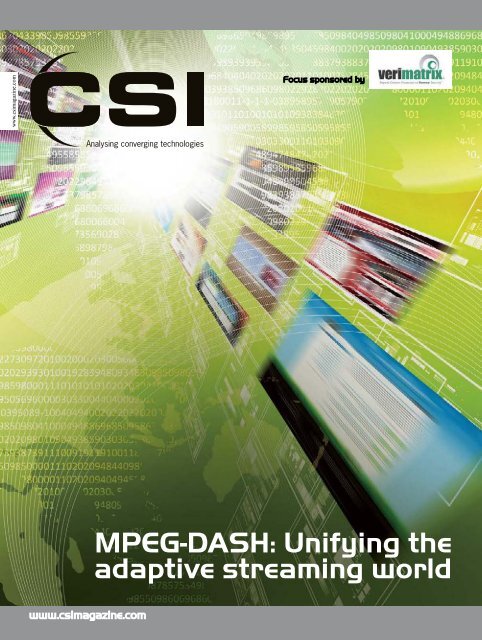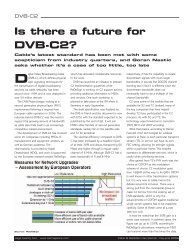MPEG-DASH: Unifying the adaptive streaming world - CSI Magazine
MPEG-DASH: Unifying the adaptive streaming world - CSI Magazine
MPEG-DASH: Unifying the adaptive streaming world - CSI Magazine
You also want an ePaper? Increase the reach of your titles
YUMPU automatically turns print PDFs into web optimized ePapers that Google loves.
www.csimagazine.com<br />
Focus sponsored by<br />
<strong>MPEG</strong>-<strong>DASH</strong>: <strong>Unifying</strong> <strong>the</strong><br />
<strong>adaptive</strong> <strong>streaming</strong> <strong>world</strong><br />
www.csimagazine.com
Sponsored feature<br />
<strong>DASH</strong>ing forward<br />
Petr Peterka & Niels Thorwirth of Verimatrix discuss<br />
leveraging <strong>MPEG</strong>-<strong>DASH</strong> – and <strong>the</strong> role of open DRM<br />
standards - for enhanced revenue security<br />
As video content becomes<br />
more diverse and<br />
ubiquitous, today’s pay-<br />
TV operators must<br />
adapt <strong>the</strong>ir services to<br />
rising subscriber<br />
expectations. Operators<br />
are <strong>the</strong>refore increasingly targeting multiple<br />
screens, ie TVs, PCs and various mobile devices,<br />
in <strong>the</strong>ir attempts to offer competitive services<br />
and reach <strong>the</strong> widest possible audience, anywhere<br />
and anytime.<br />
However, maximising <strong>the</strong> monetisation of<br />
content across a multi-network environment<br />
comes with several challenges: when <strong>the</strong> operator<br />
wants to reach beyond its managed network to<br />
various types of CE devices, including over-<strong>the</strong>-top<br />
(OTT) video <strong>streaming</strong> delivery, <strong>the</strong> issue of<br />
incompatible digital rights management (DRM)<br />
systems arises.<br />
Multi-platform challenges<br />
Managing <strong>the</strong> interplay between multiple DRM<br />
systems has long been asserted to be one of <strong>the</strong><br />
most significant barriers to successfully deploying<br />
a multi-network, multi-screen delivery<br />
environment. In fact, DRM schemes in general<br />
are often regarded as presenting many challenges<br />
for large-scale media distribution, leading some to<br />
suggest that <strong>the</strong> approach in general may be<br />
counterproductive. Interoperability, in particular,<br />
has been a difficult technical problem when<br />
dealing with a set of technologies that are, in<br />
general, highly proprietary in nature and kept<br />
closely guarded to limit <strong>the</strong> potential for<br />
commercial exposure.<br />
A unified security strategy based on an open<br />
DRM scheme, such as <strong>the</strong> ISO/IEC standard<br />
<strong>MPEG</strong>-<strong>DASH</strong> for Dynamic Adaptive Streaming<br />
over HTTP, can help operators easily address <strong>the</strong><br />
unique requirements of different devices types,<br />
giving <strong>the</strong>m <strong>the</strong> potential to<br />
open up <strong>the</strong> universe of multinetwork,<br />
multi-screen delivery,<br />
and greatly accelerate <strong>the</strong><br />
growth of new revenue streams<br />
based on this paradigm.<br />
Today’s leading edge content security strategies<br />
are characterised by <strong>the</strong> transition from a security<br />
architecture with DRM technologies in multiple<br />
competing “silos” to a more unified approach<br />
across network types and stream formats. The<br />
foundation of such an approach is that <strong>the</strong> typical<br />
DRM silos are unified via a higher-level cross-<br />
DRM “rights management” abstraction, which<br />
enables <strong>the</strong> DRM servers to operate unimpeded.<br />
This type of approach can be augmented by <strong>the</strong><br />
adoption of non-proprietary, open DRM<br />
frameworks like <strong>MPEG</strong>-<strong>DASH</strong>. Such a framework<br />
is particularly attractive as it offers operators an<br />
ideal mix of unification and flexibility – media<br />
delivery formats are unified and device<br />
au<strong>the</strong>ntication and key management processes for<br />
secure delivery remain flexible. In addition, this<br />
type of standardisation can greatly accelerate <strong>the</strong><br />
growth of new services and revenue streams for<br />
operators by opening up <strong>the</strong> universe of multi-<br />
28 March-April 2013 www.csimagazine.com
Sponsored feature<br />
network, multi-screen and delivery to a new range<br />
of standards compliant smart CE devices.<br />
It is also important to remember that rights<br />
management between <strong>the</strong> pay-TV and OTT<br />
environments should be carefully controlled since<br />
glitches in this aspect of delivery cause havoc on<br />
<strong>the</strong> management of overall subscriber<br />
expectations. Most importantly, a single security<br />
platform clearly opens up <strong>the</strong> potential for flexible<br />
business models that can help up-sell OTT<br />
content for premium services and cross-sell over<br />
multi-network, multi-screen distribution.<br />
Standardising on <strong>MPEG</strong>-<strong>DASH</strong> offers <strong>the</strong><br />
potential to open up <strong>the</strong> universe of multinetwork,<br />
multi-screen and multi-operator delivery,<br />
beyond proprietary content silos. And, by doing<br />
so, could greatly accelerate <strong>the</strong> growth of new<br />
services and revenue streams for multi-network<br />
operators. In combination with a robust<br />
protection mechanism, a whole new generation of<br />
premium services are likely to become available in<br />
<strong>the</strong> market.<br />
Exploring <strong>the</strong> status of <strong>MPEG</strong>-<strong>DASH</strong><br />
The <strong>DASH</strong> file specification is currently on track<br />
to fulfill its promise to unify <strong>the</strong> <strong>adaptive</strong><br />
<strong>streaming</strong> <strong>world</strong>. Application standards HbbTV,<br />
3GPP and DECE have standardised on <strong>MPEG</strong>-<br />
<strong>DASH</strong>, and it is anticipated that broadcast<br />
standards will likely follow suit as well.<br />
In addition, earlier this year, <strong>the</strong> <strong>DASH</strong><br />
Industry Forum released <strong>DASH</strong>264<br />
implementation guidelines 1 offering<br />
recommendations for testing and assuring<br />
interoperability. Industry-wide collaboration in <strong>the</strong><br />
creation of <strong>the</strong> <strong>DASH</strong> standard is a large part of<br />
its success; ano<strong>the</strong>r factor is <strong>the</strong> support of<br />
technical features that, as years of experience with<br />
<strong>adaptive</strong> <strong>streaming</strong> have shown, are crucial<br />
components of a mature solution.<br />
<strong>MPEG</strong>-<strong>DASH</strong> offers a number of technical and<br />
commercial benefits:<br />
• It is decoupling <strong>the</strong> technical issues of delivery<br />
formats and video compression from <strong>the</strong> more<br />
typically proprietary issues of a protection regime.<br />
In <strong>the</strong> <strong>world</strong> of <strong>DASH</strong>, no longer does <strong>the</strong><br />
technology of delivery have to develop in lockstep<br />
with <strong>the</strong> release cycle of a presentation engine or<br />
security vendor. This has been true for <strong>the</strong><br />
de-facto standard of HTTP live <strong>streaming</strong> (HLS)<br />
for some while – but is now being formalised with<br />
a broader base of technology;<br />
• It’s not blue sky technology – <strong>the</strong> standard<br />
acknowledges adoption of existing commercial<br />
offerings in its profiles and an implied transition<br />
to full standards compliance over a period of<br />
time;<br />
• It represents a drive for a single delivery<br />
protocol standard, which helps reduce<br />
balkanisation of <strong>streaming</strong> support in CE devices.<br />
More broadly available device-neutral services and<br />
less proprietary silo implementations in devices<br />
such as connected TVs should help <strong>the</strong> market<br />
grow overall; and<br />
• It provides a vendor neutral option to address<br />
<strong>the</strong> obvious current shortcomings of video<br />
support in HTML5 – <strong>the</strong> adoption of which itself<br />
is an important dynamic. This is especially<br />
notable on mobile devices, as it signifies <strong>the</strong> end<br />
of Adobe’s push to try and dominate that space<br />
with <strong>the</strong>ir own standards.<br />
The Verimatrix approach<br />
Verimatrix, by virtue of long engagement with<br />
DECE and o<strong>the</strong>r industry initiatives related to<br />
<strong>DASH</strong>, anticipated <strong>the</strong> need for more efficient,<br />
state-of-<strong>the</strong>-art approaches to <strong>the</strong> management of<br />
content protection. Consequently, content<br />
distributors of every description can implement<br />
<strong>the</strong> company’s rigorous multi-network and multidevice<br />
protection mechanisms with full<br />
confidence that <strong>the</strong>y will be able to benefit from<br />
<strong>the</strong>se new developments in <strong>adaptive</strong> <strong>streaming</strong><br />
and electronic sell-through.<br />
Last year, Verimatrix introduced Verimatrix<br />
VCAS for <strong>DASH</strong>, which offers a robust solution<br />
for <strong>the</strong>se multi-platform challenges by providing<br />
DRM and content consumption transparency<br />
across networks and devices. By providing <strong>DASH</strong><br />
support that is merged with existing Verimatrix,<br />
PlayReady and Marlin DRMs, Verimatrix has<br />
extended VCAS’ ability to enable content delivery<br />
to millions of consumer devices without complex<br />
client security integrations. This is having a<br />
profound and positive impact on <strong>the</strong> time-tomarket<br />
for operators eager to extend <strong>the</strong>ir service<br />
reach beyond <strong>the</strong>ir managed networks. Consumers<br />
are benefitting from <strong>the</strong> ease of use and<br />
transparency that follows from not having to be<br />
concerned with different DRMs. Users don’t even<br />
need to be aware what particular DRM is in use<br />
for each device.<br />
Conclusion<br />
As we look toward <strong>the</strong> future, one thing remains<br />
relatively certain: <strong>the</strong>re’s no better way to future<br />
proof an early-to-market multi-device service<br />
strategy than by adopting architectures that<br />
accommodate a multi-DRM approach. Moreover,<br />
open DRM standards can go a long way to help<br />
enable <strong>the</strong> type of consumer choice that all digital<br />
TV operators are aiming for.<br />
1<br />
Guidelines for Implementation: <strong>DASH</strong>264<br />
Interoperability Points: http://dashif.org/dash264-<br />
available-for-public-review/<br />
www.csimagazine.com March-April 2013 29
Join us for<br />
19 March 2013<br />
Breakfast Forum • Hilton Olympia Hotel<br />
verimatrix.com/tvconnect2013<br />
Visit us at<br />
TV Connect<br />
London • 19 - 21 March • Booth #173






